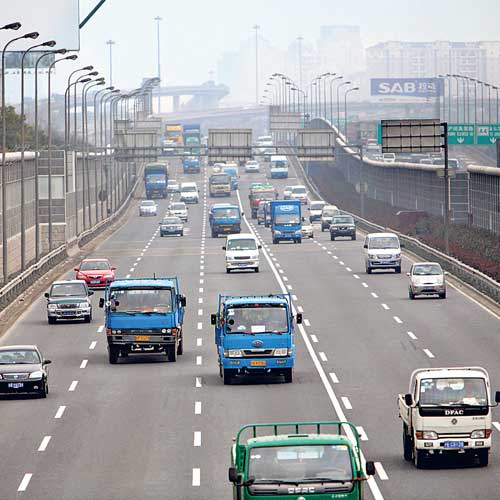IDFC Ltd. (IDFC), a financing company that is India’s largest lender to road projects, expects the government to take steps to boost investment in infrastructure projects before elections next year.
Prime Minister Manmohan Singh’s administration may accelerate approvals for highways and utilities to help revive economic growth from a decade low, IDFC Chief Executive Officer Vikram Limaye said in a Dec. 9 interview. The government may allow electricity tariffs to rise, paving the way for power projects delayed by imported coal that is about four times the price of the fuel available locally, he said.
Polls before a national election due by May signal the opposition Bharatiya Janata Party is poised to wrest control of government from Singh’s Congress party-led coalition. The premier has been under pressure to improve an infrastructure that is ranked below Kazakhstan and Guatemala by the World Economic Forum and holding back expansion in Asia’s third-biggest economy.
Borrowing Slows
The highest interest rates among the largest Asian economies have curtailed borrowing for construction projects. An inflation rate that has exceeded an average 10 percent this year has prompted the central bank to raise its benchmark interest rate twice since September.
IDFC’s loan book grew 3 percent in the 12 months to Sept. 30 — 12 times slower than a year earlier — as the lack of new infrastructure projects curbed demand for credit, exchange filings show. The company’s lending
Loans for roads and power projects account for more than 66 percent of the 560 billion rupees ($9 billion) in total lending at the Mumbai-based company, according to an investor presentation on the company’s website. IDFC’s loan book has declined in value from 566 billion rupees in March.
Infrastructure-development companies are selling assets and not starting new projects as the delay in regulatory approval hurts cash flow. GMR Infrastructure Ltd. (GMRI), an Indian builder of roads, utilities and airports, sold 74 percent of its GMR Ulundurpet Expressways unit to IDFC’s Indian Infrastructure Fund for 2.22 billion rupees, according to an exchange filing in September.
Selling Assets
IVRCL Ltd. (IVRC) agreed in April to sell its holdings in three toll roads and said it planned to divest stakes in more projects. Madhucon Projects Ltd. (MDHPJ), a builder of roads and electricity plants based in Hyderabad, plans to raise as much as 19 billion rupees by selling stakes in its highway projects, S. Vaikuntanathan, an adviser to the company, said in June.
“Our view was that infrastructure will be a secular growth story for the next 20 years in India,” Limaye said. “But now we realize that it can be quite volatile. With the rigorous implementation of announcements, we can bring it back on the growth path.”
IDFC shares have dropped 38 percent this year, while those of IVRCL and Madhucon have plunged more than 65 percent, compared with the S&P BSE Sensex index’s 6.8 percent gain. Hyderabad-based IVRCL has reported losses in four out of the past five quarters, data compiled by Bloomberg show. Madhucon posted higher profit in the three months to September, halting a nine-quarter stretch of year-on-year declines.
‘More Bleak’
“Profitability of these companies for the fiscal year ending March 2014 is more bleak than ever, and investors have kept away from investing in this sector,” Sunil Shah, head of research at Axis Securities Ltd., said by phone on Dec. 12. “The opportunity to invest in the infrastructure sector is for the brave-heart investor.”
Loans for power-related construction have been reduced amid domestic coal production hampered by delayed environmental approvals. That’s raised generation costs for utilities forced to rely on imported coal costing about four times the average price paid to Coal India Ltd. (COAL), the state-owned monopoly, according to data compiled by Bloomberg and obtained from Coal India’s website.
Removing Hurdles
The country needs to allow companies to raise rates to boost electricity generation, Limaye said. IDFC had more than 250 billion rupees of loans outstanding with power projects as of Sept. 30, little changed from a year earlier, exchange filings show.
Prime Minister Singh, who set up a panel in January to speed up infrastructure projects, said on Aug. 15 that steps are being taken to remove hurdles in the way of stalled projects.
“Investors and the market are yet to factor into the pricing the way in which infrastructure projects are being fast-tracked now,” Deepak Agarwala, an analyst at Elara Securities Ltd., said by phone on Dec. 12. “It will take 18 months before the steps by the government will translate into company profitability.”
The BJP, India’s main opposition party, will win 162 of parliament’s 545 seats, up from the 116 it holds now, with its six-party alliance taking 186, according to a poll by the C-voter polling agency, India TV and Times Now television published in October, the most recent available. The survey of 24,284 people showed the Congress-led coalition winning 117 seats — about half its current total — with other parties winning the rest.
“In the next few months, we expect that various tariff orders will be passed, clearances for projects will be given and announcements made by the government will be rigorously implemented to bolster sentiment,” Limaye said. “Many infrastructure projects are stuck in the last stages and clearing them will improve cash flows to developers.”
To contact the reporters on this story: Anto Antony in Mumbai at [email protected]; George Smith Alexander in Mumbai at [email protected]
To contact the editor responsible for this story: Darren Boey at [email protected]
Source-http://www.businessweek.com

 Ashutosh Kumar
Ashutosh Kumar










